Personally, my screen time report has increased by 50% in the last three weeks, and while I can’t know for sure, I’d be willing to bet I’m not the only (hypothetical) member of your audience segments for which that’s the case.
As we all practicing social distancing, I’ve seen myself turn to digital devices more—Zoom, news, mobile games, e-learning, online shopping, and of course, a little Netflix binging have all been part of my new daily routine.
I say this because while it’s true for many, when I thought about it, it’s also distinctly different from my old digital routine. No longer have I been researching weekend getaways, checking Fandango for the latest horror movie to hit the theatre or listening to podcasts as much, since my commute is currently nonexistent.
Instead, I’ve filled those digital moments with other online activity—I read a lot more Wait But Why and National Geographic articles, signed up for a couple of Google marketing courses and have started an educational journey down the road of investing.
Now donning my marketer hat—I realize this incredibly abrupt change matters to advertisers who’d been previously targeting me, and many like me, before COVID-19 set off a chain reaction of new digital behavior en masse.
To find, engage, and eventually, convert consumers in their new digital routines, you need to adjust your targeting strategy. Using data pulled from over 1.4 billion open web visitors a month, I’m going to walk through how you do so:
- Pay attention to what people are organically reading—this signals new areas of interest.
- Pay attention to where advertisement CTRs are rising, to capitalize on the areas where there are demand.
- Selectively A/B test new audience segments based on those learnings
- Adjust your ad creatives for those audiences to effectively capture engagement
Basically, you need to backtrack to square one—but you don’t need to wipe the whole board—all that’s needed is a little bit of research and testing to find your new niche.
What are people organically interested in?
There’s been an explosion of traffic to online publisher sites in the past month, and certain news categories are grabbing people’s attention more than others.
To best understand the change in interests, we took a look at the average number of daily readers in each category over the last 10 weeks, and compared it to the average in the last two weeks. These percentages indicate the change we’ve seen in those categories over the last two weeks.
When it comes to the news, we’ve naturally seen increases in categories related to the global pandemic, but also in categories like technology & computing, lifestyle, health & fitness, and arts & entertainment:
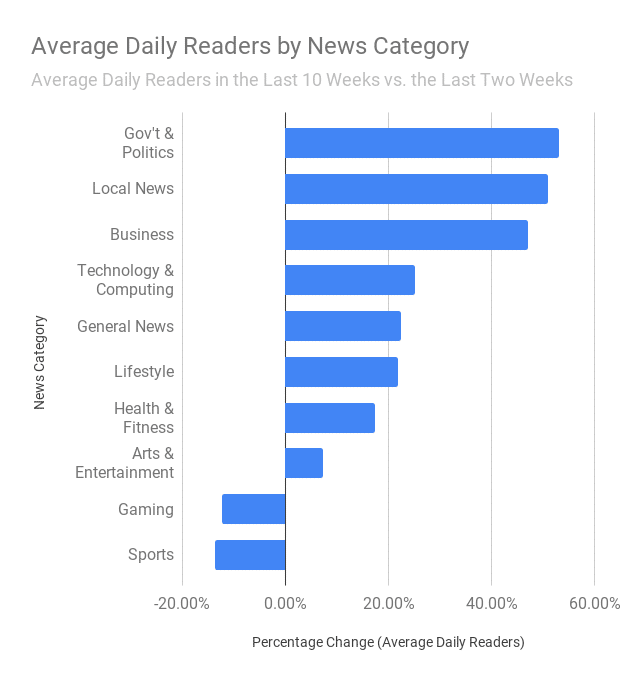
This new wave of interest should feel like an alarm that just won’t stop beeping, or a push notification you just can’t clear. It should signal loudly and clearly where your consumers are now, and act as the springboard to the evolution of your targeting strategy.
How does this translate to engagement with ads?
Right now, the trends we see in organic content consumption are translating to higher CTRs on sponsored content—the news categories attracting more readers correlate with the advertising verticals that are thriving on those publisher sites.
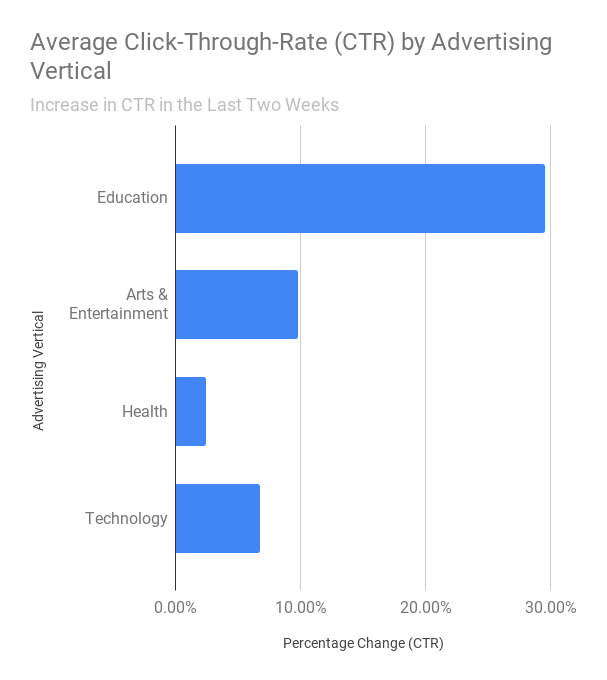
Demand has increased most significantly for education content and products, while also healthily growing in arts & entertainment, health and technology.
How to find and use new audience segments relevant to changes in consumer behavior online.
Great, we know what general categories people are gravitating towards—but what does that actually mean for your audience segments (and what if you’re not a part of those verticals?
First, it’s important to back up here and remember that people on the open web (those reading all those news articles we mentioned before) behave differently than people on social and search channels—they’re open to discovering something new, including new brands and products they wouldn’t have thought to engage with before.
This fact, coupled with the fact that there’s likely been a shift in your audience’s digital behavior, means one thing:
Ideally, you should relax your current targeting strategies, opening the gates for new audiences to engage with you. If you’re new to open web advertising, then we actually recommend you start with no targeting at all.
Do this for a week (or two, if you’re comfortable) and see what new audiences you attract. For a more aggressive approach, increase your bids to a ceiling with which you’re comfortable, further increasing the chances you’ll win more consumer clicks.
If you’re not comfortable opening up the gates entirely, then consider A/B testing interest targeting related to the verticals that are seeing increased CTRs.
Interest targeting: test segments in relevant categories (even if you’re not in them).
Here are a few examples of Taboola segments in each category, and you can imagine comparable examples from other data providers with whom you might be working:
General
Fitness brands might want to lean-in to products and content relevant to the at-home worker, or a provider of natural health supplements might want to pivot to targeting those directly interested in the global pandemic with segments like:
- Interest > Coronavirus
- Behavior > Work from home
Using one or more of these audience segments, here’s what those examples campaigns cool look like at each stage of a basic funnel:
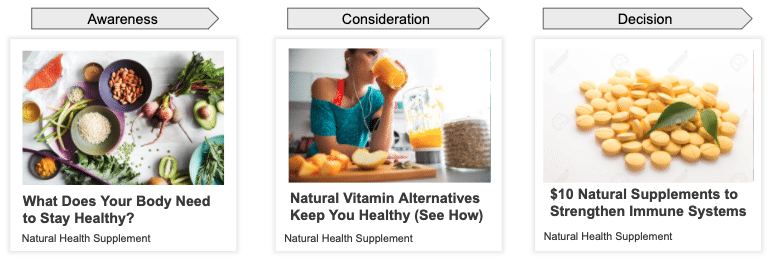
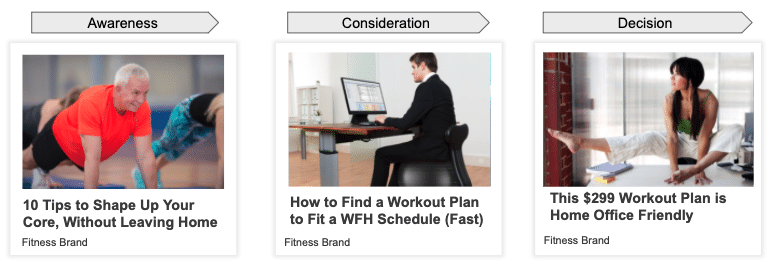
Education
Bookstore brands and publishers could capitalize a new wave of self-education, while communication tools might want to focus on helping school alumni and students stay connected while distanced from campus. The segments could help:
- Interest > Online Behavior > Education Engagers
- Education > High School
- Education > Graduate School
- Interest > Entertainment > Books and Literature (Poetry, Fan Fiction, Science Fiction)
- Behavior > Shopping > Back to School
- Education > Alumni and Reunions
- Interest > Lifestyle > Education > Interest in College and Educational Loans
Hopefully, these example creatives can get the wheels turning:
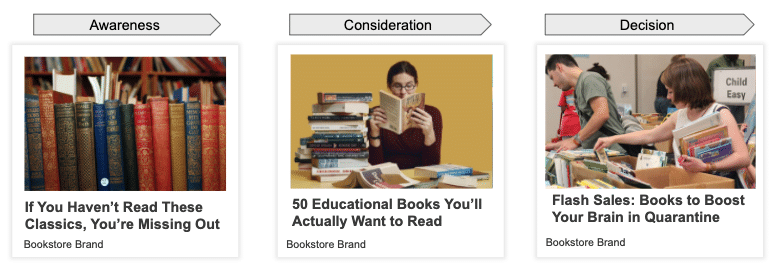
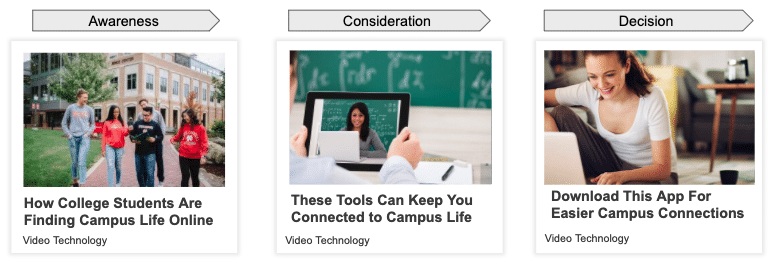
Arts & Entertainment
Sports brands could surface sources of relevant entertainment for the audiences while games have been cancelled, or business brands might consider offering relevant promos to consumers purchasing their product, depending on the audience of choice.
- Interest > Entertainment > Events
- Interest > Entertainment > Movies and TV
- Interest > Entertainment > Performing Arts
- Interest > Entertainment > Reality and Talk Television
- Interest > Entertainment > Streaming Content
- Interest > Entertainment > Dance
- Interest > Entertainment > Online Gaming
- Interest > Entertainment > Superhero Enthusiasts
- Lifestyle > Entertainment > Comics and Manga
- Lifestyle Entertainment > Music Engagers
Again, here are those examples laid out in a basic funnel for inspiration:
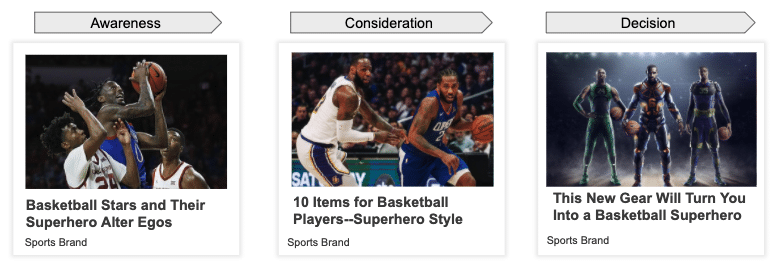
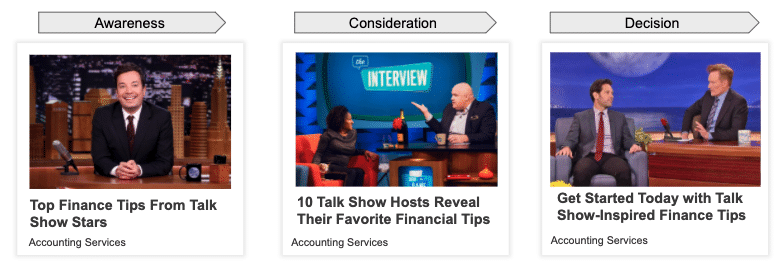
Health
At home fitness is the obvious fit here, but restaurants could consider targeting consumers of interest here as well with healthy food tips, or mental health and wellness professionals can find their niche as people look to improve their physical wellness.
- Interest > Health and Fitness
- Interest > Health > Weight Loss
- Interest > Health > Natural Products
- Interest > Health > Wellness
- Interest > Health and Fitness > Exercise
- Interest > Health > Exercise > Exercise Videos
- Interest > Health > Healthy Lifestyle Engagers
Visual are next—here’s how this could look when aligning with your creative strategy:
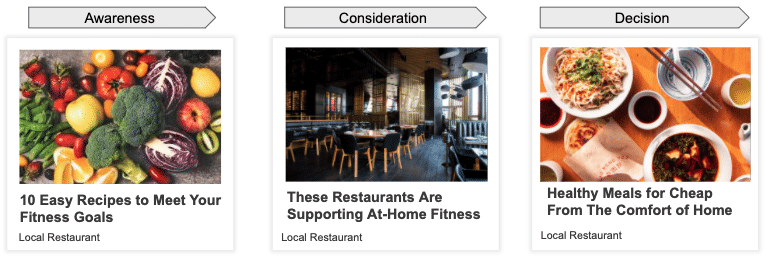
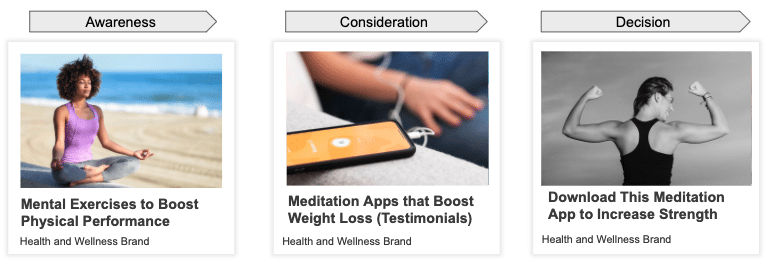
Technology
Finally, we make it to the tech world. While those who actually sell technology services and products should double down on advertising now, other verticals, like beauty and fashion brands, can adapt to reach users with segments like:
- Interest > Technology and Computing
- Interest > Technology > Tech Engagers
- Interest > Technology > Computing > Internet Technology > Email
- Interest > Technology > Smartphones
- Interest > Technology > Consumer Electronics
- Interest > Finance > Investment Technology
Here are some ad creative examples:
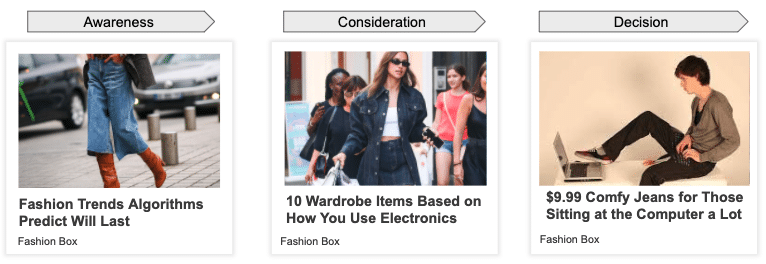
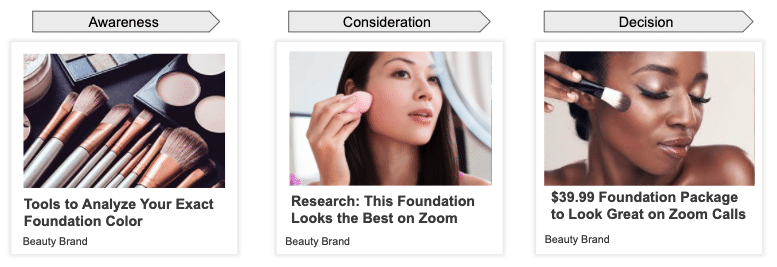
The willingness to test new audience segments and a little out-of-the box thinking when it comes to your creative strategy can help you capitalize on open web trends. Test multiple interests in a separate campaign to scale your reach if needed, but remember, smaller audiences are typically easy to reach.
But, at the end of the day, some of the audience segments that you’re testing will work, and some of them will not. Once you’ve identified which is which, look to lookalike audiences to scale your reach.
Lookalike targeting: once you’ve found your new niche, grow your audience with lookalike audiences.
Lookalike audiences are just that—they’re audiences that look like audiences you know are working for you—and are key to scaling your reach quickly after an abrupt strategy pivot.
Those audiences should be built based on the audience segments with the highest conversion rates and CTRs, but you’ll have to make sure that you’re pixel-tracking your campaigns before you can use them.
Here are some ideas to get started easily:
- Duplicate a successful campaign with the addition of a lookalike segment
- Narrow it down using audiences from specific webpages or even purchasers
- To reach a lower percentage lookalike segment, launch with a higher CPC.
Then, you’re off and running. The key to success in our new marketing reality will be keeping a close eye on where consumer attention shifts next.
As always, A/B testing, constant measurement and willingness to experiment are your friends. Use these techniques to reach those consumers you know, and those who might not have gotten the chance to know you yet, as digital behavior continues to evolve in the wake of our global pandemic.